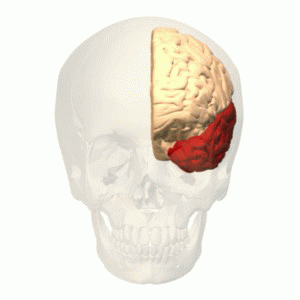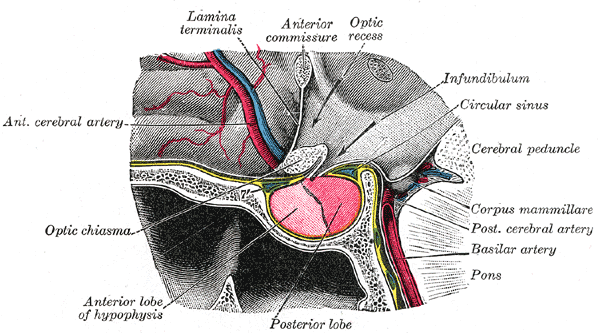|
Pure Word Deafness
Auditory verbal agnosia (AVA), also known as pure word deafness, is the inability to comprehend speech. Individuals with this disorder lose the ability to understand language, repeat words, and write from dictation. Some patients with AVA describe hearing spoken language as meaningless noise, often as though the person speaking was doing so in a foreign language. However, spontaneous speaking, reading, and writing are preserved. The maintenance of the ability to process non-speech auditory information, including music, also remains relatively more intact than spoken language comprehension. Individuals who exhibit pure word deafness are also still able to recognize non-verbal sounds. The ability to interpret language via lip reading, hand gestures, and context clues is preserved as well. Sometimes, this agnosia is preceded by cortical deafness; however, this is not always the case. Researchers have documented that in most patients exhibiting auditory verbal agnosia, the discriminati ... [...More Info...] [...Related Items...] OR: [Wikipedia] [Google] [Baidu] |
Lip Reading
Lip reading, also known as speechreading, is a technique of understanding a limited range of speech by visually interpreting the movements of the lips, face and tongue without sound. Estimates of the range of lip reading vary, with some figures as low as 30% because lip reading relies on context, language knowledge, and any residual hearing. Although lip reading is used most extensively by deaf and hard-of-hearing people, most people with normal hearing process can infer some speech information by observing a speaker's mouth. Process Although speech perception is considered to be an auditory skill, it is intrinsically multimodal, since producing speech requires the speaker to make movements of the lips, teeth and tongue which are often visible in face-to-face communication. Information from the lips and face supports aural comprehension and most fluent listeners of a language are sensitive to seen speech actions (see McGurk effect). The extent to which people make use of seen ... [...More Info...] [...Related Items...] OR: [Wikipedia] [Google] [Baidu] |
Temporal Lobe
The temporal lobe is one of the four major lobes of the cerebral cortex in the brain of mammals. The temporal lobe is located beneath the lateral fissure on both cerebral hemispheres of the mammalian brain. The temporal lobe is involved in processing sensory input into derived meanings for the appropriate retention of visual memory, language comprehension, and emotion association. ''Temporal'' refers to the head's temples. Structure The temporal lobe consists of structures that are vital for declarative or long-term memory. Declarative (denotative) or explicit memory is conscious memory divided into semantic memory (facts) and episodic memory (events). The medial temporal lobe structures are critical for long-term memory, and include the hippocampal formation, perirhinal cortex, parahippocampal, and entorhinal neocortical regions. The hippocampus is critical for memory formation, and the surrounding medial temporal cortex is currently theorized to be critical f ... [...More Info...] [...Related Items...] OR: [Wikipedia] [Google] [Baidu] |
Language Disorders
Language disorders or language impairments are disorders that involve the processing of linguistic information. Problems that may be experienced can involve grammar (syntax and/or morphology (linguistics), morphology), semantics (meaning), or other aspects of language. These problems may be receptive (involving impaired language comprehension), expressive (involving language production), or a combination of both. Examples include specific language impairment, better defined as developmental language disorder, or DLD, and aphasia, among others. Language disorders can affect both spoken and written language, and can also affect sign language; typically, all forms of language will be impaired. Current data indicates that 7% of young children display language disorder, with boys being diagnosed twice as often as girls. Preliminary research on potential risk factors have suggested biological components, such as low birth weight, premature birth, prematurity, general birth complic ... [...More Info...] [...Related Items...] OR: [Wikipedia] [Google] [Baidu] |
Audiology
Audiology (from Latin 'to hear'; and from Ancient Greek, Greek branch of learning , ''wikt:-logia, -logia'') is a branch of science that studies hearing, balance, and related disorders. Audiologists treat those with hearing loss and proactively prevent related damage. By employing various testing strategies (e.g. behavioral hearing tests, otoacoustic emission measurements, and electrophysiologic tests), audiologists aim to determine whether someone has normal sensitivity to sounds. If hearing loss is identified, audiologists determine which portions of hearing (high, middle, or low frequencies) are affected, to what degree (severity of loss), and where the lesion causing the hearing loss is found (outer ear, middle ear, inner ear, auditory nerve and/or central nervous system). If an audiologist determines that a hearing loss or vestibular abnormality is present, they will provide recommendations for interventions or rehabilitation (e.g. hearing aids, cochlear implants, appropria ... [...More Info...] [...Related Items...] OR: [Wikipedia] [Google] [Baidu] |
Deafness
Deafness has varying definitions in cultural and medical contexts. In medical contexts, the meaning of deafness is hearing loss that precludes a person from understanding spoken language, an audiological condition. In this context it is written with a lower case ''d''. It later came to be used in a cultural context to refer to those who primarily communicate with a deafness aid or through sign language regardless of hearing ability, often capitalized as ''Deaf'' and referred to as "big D Deaf" in speech and sign. The two definitions overlap but are not identical, as hearing loss includes cases that are not severe enough to impact spoken language comprehension, while cultural Deafness includes hearing people who use sign language, such as children of deaf adults. Medical context In a medical context, deafness is defined as a degree of hearing difficulties such that a person is unable to understand speech, even in the presence of amplification. In profound deafness, eve ... [...More Info...] [...Related Items...] OR: [Wikipedia] [Google] [Baidu] |
Auditory Processing Disorder
Auditory processing disorder (APD) is a neurodevelopmental disorder affecting the way the brain processes sounds. Individuals with APD usually have normal structure and function of the ear, but cannot process the information they hear in the same way as others do, which leads to difficulties in recognizing and interpreting sounds, especially the sounds composing speech. It is thought that these difficulties arise from dysfunction in the central nervous system. A subtype is known as King-Kopetzky syndrome or auditory disability with normal hearing (ADN), characterised by difficulty in hearing speech in the presence of background noise. This is essentially a failure or impairment of the cocktail party effect ( selective hearing) found in most people. The American Academy of Audiology notes that APD is diagnosed by difficulties in one or more auditory processes known to reflect the function of the central auditory nervous system. It can affect both children and adults, and may ... [...More Info...] [...Related Items...] OR: [Wikipedia] [Google] [Baidu] |
Diazepam
Diazepam, sold under the brand name Valium among others, is a medicine of the benzodiazepine family that acts as an anxiolytic. It is used to treat a range of conditions, including anxiety disorder, anxiety, seizures, alcohol withdrawal syndrome, muscle spasms, insomnia, and restless legs syndrome. It may also be used to cause amnesia, memory loss during certain medical procedures. It can be taken Oral administration, orally (by mouth), as a suppository inserted into the rectum, Intramuscular injection, intramuscularly (injected into muscle), Intravenous therapy, intravenously (injection into a vein) or used as a nasal spray. When injected intravenously, effects begin in one to five minutes and last up to an hour. When taken by mouth, effects begin after 15 to 60 minutes. Common side effects include sleepiness and trouble with coordination. Serious side effects are rare. They include increased risk of suicide, decreased breathing, and a paradoxical increased risk of seizures ... [...More Info...] [...Related Items...] OR: [Wikipedia] [Google] [Baidu] |
Intravenous Immunoglobulin
Immunoglobulin therapy is the use of a mixture of antibodies (normal human immunoglobulin) to treat several health conditions. These conditions include primary immunodeficiency, immune thrombocytopenic purpura, chronic inflammatory demyelinating polyneuropathy, Kawasaki disease, certain cases of HIV/AIDS and measles, Guillain–Barré syndrome, and certain other infections when a more specific immunoglobulin is not available. Depending on the formulation it can be given by injection into muscle, a intravenous, vein, or subcutaneous injection, under the skin. The effects last a few weeks. Common side effects include pain at the site of injection, muscle pain, and allergic reactions. Other severe side effects include kidney problems, anaphylaxis, blood clots, and red blood cell breakdown. Use is not recommended in people with some types of IgA deficiency. Use appears to be relatively safe during pregnancy. Human immunoglobulin is made from human blood plasma. It contains antibo ... [...More Info...] [...Related Items...] OR: [Wikipedia] [Google] [Baidu] |
Sign Language
Sign languages (also known as signed languages) are languages that use the visual-manual modality to convey meaning, instead of spoken words. Sign languages are expressed through manual articulation in combination with #Non-manual elements, non-manual markers. Sign languages are full-fledged natural languages with their own grammar and lexicon. Sign languages are not universal and are usually not mutual intelligibility, mutually intelligible, although there are similarities among different sign languages. Linguists consider both spoken and signed communication to be types of natural language, meaning that both emerged through an abstract, protracted aging process and evolved over time without meticulous planning. This is supported by the fact that there is substantial overlap between the neural substrates of sign and spoken language processing, despite the obvious differences in modality. Sign language should not be confused with body language, a type of non verbal communicati ... [...More Info...] [...Related Items...] OR: [Wikipedia] [Google] [Baidu] |
Primary Progressive Aphasia
In neurology, primary progressive aphasia (PPA) is a type of neurological syndrome in which language capabilities slowly and progressively become impaired. As with other types of aphasia, the symptoms that accompany PPA depend on what parts of the brain's left hemisphere are significantly damaged. However, unlike most other aphasias, PPA results from continuous deterioration in brain tissue, which leads to early symptoms being far less detrimental than later symptoms. Those with PPA slowly lose the ability to speak, write, read, and generally comprehend language. Eventually, almost every patient becomes mute and completely loses the ability to understand both written and spoken language. Although it was first described as solely impairment of language capabilities while other mental functions remain intact, it is now recognized that many, if not most of those with PPA experience impairment of memory, short-term memory formation and loss of executive functions. It was fi ... [...More Info...] [...Related Items...] OR: [Wikipedia] [Google] [Baidu] |
Third Ventricle
The third ventricle is one of the four connected cerebral ventricles of the ventricular system within the mammalian brain. It is a slit-like cavity formed in the diencephalon between the two thalami, in the midline between the right and left lateral ventricles, and is filled with cerebrospinal fluid (CSF). Running through the third ventricle is the interthalamic adhesion, which contains thalamic neurons and fibers that may connect the two thalami. Structure The third ventricle is a narrow, laterally flattened, vaguely rectangular region, filled with cerebrospinal fluid, and lined by ependyma. It is connected at the superior anterior corner to the lateral ventricles, by the interventricular foramina, and becomes the cerebral aqueduct (''aqueduct of Sylvius'') at the posterior caudal corner. Since the interventricular foramina are on the lateral edge, the corner of the third ventricle itself forms a bulb, known as the ''anterior recess'' (it is also known as the ''bulb ... [...More Info...] [...Related Items...] OR: [Wikipedia] [Google] [Baidu] |
Embolism
An embolism is the lodging of an embolus, a blockage-causing piece of material, inside a blood vessel. The embolus may be a blood clot (thrombus), a fat globule (fat embolism), a bubble of air or other gas (air embolism, gas embolism), amniotic fluid (amniotic fluid embolism), or foreign body, foreign material. An embolism can cause partial or total blockage of blood flow in the affected vessel. Such a blockage (vascular occlusion) may affect a part of the body distant from the origin of the embolus. An embolism in which the embolus is a piece of thrombus is called a thromboembolism. An embolism is usually a pathological event, caused by illness or injury. Sometimes it is created intentionally for a therapeutic reason, such as to hemostasis, stop bleeding or to kill a cancerous tumor by stopping its blood supply. Such therapy is called embolization. Classification There are different types of embolism, some of which are listed below. Embolism can be classified based on wher ... [...More Info...] [...Related Items...] OR: [Wikipedia] [Google] [Baidu] |






